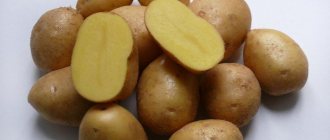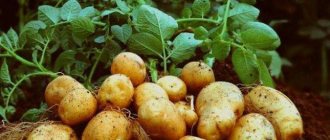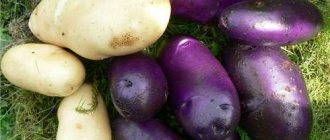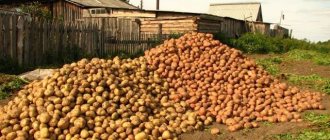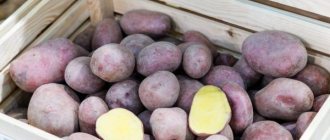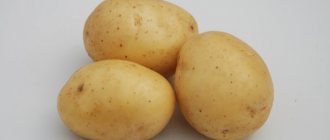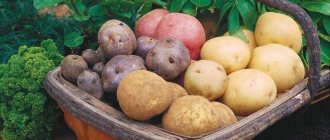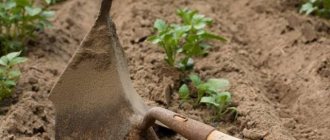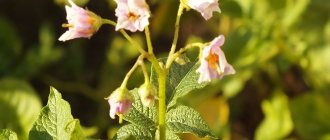Potato variety Kurazh
Courage is a mid-early table potato variety (Solanum tuberosum) of Dutch selection.
Brought out by specialists in the early 2000s. In 2007, it was included in the state register of plants of the Russian Federation in two regions: Central (Bryansk, Vladimir, Ivanovo, Kaluga, Moscow, Ryazan, Smolensk, Tula regions) and Central Black Earth (Belgorod, Voronezh, Kursk, Lipetsk, Oryol, Tambov regions ). Valued for the excellent presentation of the tubers and their high starch content. It is drought resistant. Suitable for processing into chips. The time from the appearance of full shoots to ripening is 80−90 days.
The plant is tall or medium, intermediate type. The main stem is erect or semi-erect. The leaves are medium or large, of intermediate type, dark green in color, sometimes lighter. The edges of the leaf blade are medium or slightly wavy. The corolla is medium in size, sometimes large, red-violet in color.
In one nest, 6-9 large homogeneous tubers weighing 98-144 grams, oval-round regular shape are formed. The potato skin has a mesh structure, smooth or slightly rough to the touch, and red in color. The pulp is light yellow when cut and does not darken upon contact with air and metal, as well as during heat treatment.
The marketable yield of the variety, according to the results of state tests, was noted in the range of 159−270 c/ha, at the level of the Elizaveta and Ilyinsky standards. The largest amount was collected in the Vladimir region - 435 c/ha were received per hectare of area, 223 c/ha more than Elizaveta’s results. Thus, the potential yield is about 350 c/ha, and it can be consistently achieved in certain regions with the right agricultural technology. The marketability of tubers is at a very high level - 83−99%, keeping quality is also excellent - 91%.
Courage has excellent taste! The pulp boils well, making the tubers perfect for making purees. But they will also work very well in other dishes. When cooked, they do not lose their color, so when cooked they look very appetizing. The starch content in the pulp is quite high - 13−19.9%; because of this feature, the variety is ideal for making chips.
Plants are very demanding on soil fertility, so it is more advisable to grow these potatoes on light soils rich in nutrients and microelements. That is why this variety is most common in central Russia. Light loams and sandy loams are best suited for cultivation. The plants are unpretentious in care and tolerate drought very well, even quite long-term ones. But cold weather has a painful effect on them, which makes Courage not particularly suitable for cultivation in northern latitudes. Listed below are some features of agricultural technology that will help you achieve better yields.
- Before planting, it is strongly recommended to germinate the tubers to improve germination and reduce ripening time. It is also advisable to treat the seed material with growth stimulants. Don’t forget about treating with drugs against diseases and pests.
- Planting depth is 10 cm on sandy loam, 8 cm on light loam. The distance between the holes should be about 35 cm, the row spacing should be 70 cm.
- During the growing season of plants, it is necessary to carry out standard agrotechnical measures. Loosening, hilling, weeding, treatment against pests and diseases - all this can greatly affect the yield. Don't forget about watering. As already mentioned, plants tolerate drought well, but a very long absence of moisture can be disastrous for them.
- Add fertilizer to the soil as needed. Be careful with nitrogen complexes - their increased content in the soil can lead to an increase in the growth rate of tops. In this case, tuberization may slow down.
- Maintain crop rotation. This is very important for this variety because of its weak resistance to late blight. It is best to choose a site after growing legumes, beets, cabbage, onions, cucumbers, garlic, and green manure.
- Do not forget about timely renewal of seed material. This will help avoid degeneration, in which the tubers begin to shrink and take on bizarre shapes.
Our hero is resistant to the causative agent of cancer and the golden cyst nematode. According to the All-Russian Research Institute of Phytopathology, it is moderately susceptible to late blight on tops and tubers, but preventive measures should not be neglected.
Gardeners value Courage very much for its excellent taste and very good boilability of tubers. The advantages also include quite high yields, excellent presentation of potatoes, and excellent keeping quality. But there are few disadvantages - moderate susceptibility to late blight, and, perhaps, the plants are demanding on soils and climate. Otherwise, this is a very good variety that clearly deserves your attention!
Cultivation is officially carried out by: ZAO Oktyabrskoye in the Leningrad region, LLC Alchak in Tatarstan, IP Kolyasin Sergey Nikolaevich in Omsk, CJSC Teplichny in the Omsk region, LLC Alrost in the Chuvash Republic, LLC Teplichno- greenhouse plant "Elite-Potato" in Omsk, CJSC "Prinevskoe Breeding Plant" in the Leningrad region, LLC "Udmurtsoyproduct" in Udmurtia, LLC "Elite Potato" in Tatarstan, Federal State Budgetary Institution "Federal Agrarian Research Center of the North-East named after N V. Rudnitsky."
Characteristics of the variety
The potato variety "Courage" was created in Holland, and was entered into the State Register of the Russian Federation in 2007. This variety has a relatively impressive yield and can produce 16-27 tons of fruit per hectare.
With proper care and compliance with key requirements, “Courage” can produce up to 40 tons of potatoes per hectare. It may not be the most prolific potato variety, but given its heat tolerance and great disease resistance, it is quite capable of competing with many.
This variety also has serious shelf life, that is, it is able to withstand a long shelf life in proper conditions (while other varieties are already beginning to deteriorate and rot). The shelf life level of “Courage” remains stable at 91%, which is a very impressive figure.
“Courage” is a mid-late potato variety, that is, the harvest should be expected 85-95 days after the first shoots. The marketability of the emerging fruits is estimated at 83-99%.
The following will list the main characteristics of the “Courage” potato variety:
- "Courage" is critically drought tolerant;
- stands out for its beautiful and even tubers;
- has a high starch content (14-20%);
- the weight of marketable tubers is not less than 100 grams (up to 140 g);
- There are 6-9 tubers per bush;
- the yield is at 160-270 c/ha;
- the color of the peel is red, and the flesh is light yellow;
- the preferred region for cultivation is central;
- has serious resistance to potato cancer, scab and golden cyst nematode;
- the fruits have very good friability;
- the tubers have an elongated oval shape.
Description of the variety
Roots:
- Large tubers, average weight - from 100 to 140 grams;
- Root vegetables have an elongated oval shape;
- Pink-red peel;
- Medium ocelli, slightly offset;
- The pulp is yellowish when cut;
- Starch content - 20%.
Popular potato varieties:
Escapes:
- Quite tall bushes;
- Type erect or semi-erect;
- Dark green leaves of medium to large size;
- During the flowering period, beautiful large flowers with purple corollas appear;
- Each bush produces from 10 to 12 tubers.
We invite you to familiarize yourself with potato varieties that have different ripening periods:
| Late ripening | Early ripening | Very early | Mid-late | Mid-early |
| Nikulinsky | Borovichok | Forty days | Crane | Yanka |
| Cardinal | Elmundo | Karatop | Sorcerer | Giant |
| Rocco | Felox | Riviera | Mozart | Tuscany |
| Kiwi | Bellarosa | Zhukovsky early | Grenada | Purple Haze |
| Ivan da Marya | Natasha | Farmer | Melody | Openwork |
| Picasso | Ariel | Minerva | Margarita | Santana |
| Asterix | Queen Anne | Veneta | Ramona | Desiree |
| Slav | Arosa | Kiranda | Dolphin | Lady Claire |
Key rules for growing "Courage"
This type of potato belongs to the table type, but if you delve into the study of its main characteristics, it becomes clear that it can also be used for processing into pure starch in industry.
But first you need to carefully study the basic rules for caring for and growing potatoes. If they are neglected, the plants will die in the shortest possible time, never having matured.
Landing
It is extremely important to choose the right time for planting “Courage”. This potato variety has serious resistance to high temperatures, but it succumbs to cold weather and frosts. And in the regions prescribed for “Courage”, there can be cold weather even in May. If young shoots do survive cold spells and frosts, their growth and development may be affected, causing the fruit to be of much lower quality than it should be.
The ideal time for planting is the first 10 days of May (approximately, because it all depends on the temperature).
Planting material should be germinated in advance (at least 20 mm of the length of sprouts on tubers), and it should be planted in soil heated to approximately 10 degrees.
For greater efficiency, right before planting, you can treat the tubers with special growth regulators (Heteroauxin, Zircon, Kornevin). They will increase the likelihood of tubers forming, improve plant immunity, and may even speed up the time when the fruits finally ripen.
The main thing is not to overdo it - everything is good, but in moderation.
Planting scheme
Potatoes of the “Courage” variety feel best on moderately acidic soil, where the pH value is average. Planting should be done 70x35 (that is, 70 cm between rows, and 35 cm between tubers in a row). Regarding the depth, in light sandy soils - 10 cm, in light loamy soils - up to 8 cm.
If you plan to use fertilizers, it would be more correct to use those that do not contain chlorine and are water-soluble (potassium sulfate, urea, etc.).
Planting material
Before planting, the tubers need not only to be treated with growth regulators, but also to be directly heated in the sun for an hour and a half. The best planting material is medium-sized tubers with sprouts up to 20 mm.
Hilling
During 1 season, it is recommended to carry out at least 3 hillings:
- the first - when the plants grow more than 10 cm;
- the second - 2-3 weeks after the previous one, usually at the time of flowering;
- the third - when “Courage” reaches a height of 20-25 cm.
Loosening
In addition to keeping the soil clean (which goes without saying), its looseness is also important. The soil must be loose - in this way oxygen will more effectively saturate the soil, which is critically important for any plants, not just “Courage”.
If the soil itself is loose, then digging it up is not required. But if it’s the other way around, the loosening procedure must be carried out. This will help the tubers develop properly and the harvest will be impressive.
Watering
Potatoes of the “Courage” variety must be watered. Moreover, this should be done throughout the entire growing season - from planting to harvest.
To understand the required amount of water for irrigation, you need to analyze the soil in which potatoes are grown. But since “Courage” needs to be grown in loose soil, 3-4 liters of water should be poured onto one bush. If the soil were harder/dense, much less water would be needed.
If the season is marked by an abundance of rain, then additional watering is not necessary. At least not in large quantities.
Before watering, you need to pause for several days until the soil surface is completely dry.
Diseases and pests
As already mentioned, “Courage” is resistant to serious diseases, but is rather weak against late blight pathogens. Late blight can easily destroy 60% of the entire crop if measures are not taken against its effects in advance.
How to grow
To obtain a rich and tasty harvest, complex agricultural practices are not required . It is enough to follow the standard rules for growing potatoes. Proper watering in combination with loosening, weeding and hilling ensure high-quality fruiting and keep the bushes healthy.
Pre-sowing treatment
Tuber preparation begins a month before sowing .
Each potato is carefully inspected for visible damage and disease. Spoiled seed material is disposed of. The remaining potatoes are laid out in a bright room at a temperature of +15...+17°C.
Tubers weighing no more than 100 g are selected for planting . Large root crops are subsequently cut and planted in slices. The seed material is germinated within a month, otherwise it will not sprout.
Important! Immediately before planting, the tubers are treated with a Fitosporin solution. This is a contact fungicide that protects seed material and seedlings from damage by fungal diseases.
Planting dates and scheme
Planting dates for the Courage variety are especially important . The ideal period for sowing is the first ten days of May. In the southern regions, you can focus on the end of April, but do not forget about returning frosts.
Reference. A sharp cold snap negatively affects the development of bushes. The tubers are formed smaller and differ in taste.
The soil is prepared in the fall : it is dug up with the addition of humus and wood ash.
In the spring, the soil is dug up again. Before planting, a full range of mineral fertilizers is applied to the soil. The tubers are planted to a depth of 8-10 cm. A little wood ash is placed in each hole and covered with earth.
Planting pattern : 35 cm - distance between holes, 70-75 cm - row spacing. With this planting scheme, it is convenient to care for potatoes, and the risk of diseases is reduced.
The soil temperature at the time of planting should be at least +10°C.
Further care for Courage potatoes
Crop care comes down to standard procedures that even a novice gardener can handle.
Watering
From the description of the variety it follows that it is drought resistant .
But this does not mean that the plant need not be watered at all. Watering is required throughout the growing season, especially during budding and after flowering. The drier the weather, the more water is used for each bush. In normal climates, water consumption is no more than 6 liters , and on hot, hot days it increases to 10 liters. The best indicator of watering is the top layer of soil. Do not allow it to dry out completely. The beds are kept moderately moist. In rainy weather, the amount of watering is reduced.
After watering, the wet soil is usually loosened and weeds are removed . Loosening improves air exchange, which contributes to the normal functioning of the crop. Weeds carry many diseases and serve as a favorite habitat for various insect pests, so the proximity of cultivated plants to them is undesirable. In addition, weeds take a lot of useful substances from the ground, and seedlings suffer from a lack of nutrients.
Reference . An increased level of humidity in the beds leads to the development of fungal diseases.
Hilling is carried out three times per season . It protects the tubers from direct sunlight. For the first time, the plants are earthed up as soon as they grow to 10 cm. The second procedure occurs at the time of flowering, and the third is carried out when the seedlings reach 25 cm.
Feeding
In addition to the main fertilizers, foliar fertilizers are used. The first is carried out after planting when the seedlings grow poorly.
Plants are fertilized with urea and ammonium nitrate. The crop also responds well to the introduction of nitrogenous substances at the initial stage. During flowering, a second fertilizing with a predominant phosphorus content is applied. Also at this stage they fertilize with organic matter - bird droppings in a ratio of 1:10. The resulting solution is treated between the rows after abundant watering.
When the tubers ripen, the plants are fed with potassium fertilizers, thanks to which the root crops quickly gain weight and ripen.
Important! Potatoes take the main part of the nutrients for the formation of tubers from fertilizers applied during spring digging of the soil. Therefore, the land is abundantly supplied with humus and wood ash.
Diseases and pests
If you do not prevent late blight, the risk of its development increases . This fungal disease can destroy up to 70% of all plantings and easily spreads to other crops.
Protection against fungus begins with the preparation of seed, when sprouted tubers are treated with Fitosporin. During the growth of seedlings, the drugs “Ridomil” or “Avixil” are used. Preventive measures also include moderate watering, timely fertilizing and loosening the soil.
In case of disease, the affected areas of the plants are removed , and the seedlings are sprayed with Fitosporin.
Fungal spores are well preserved in weeds.
This is another reason why you should clear your beds of them. Among the insects that harm potatoes are :
- Colorado potato beetle . It is collected by hand along with the larvae that appear on the inner surface of the leaves. When there is a large concentration of pests, the insecticide “Confidor” is used.
- Medvedka . It is difficult to notice, as it moves underground and damages the root system. Subsequently, the plant does not receive sufficient nutrition and dies. In the fight against mole crickets, the drug “Medvetox” is used, the granules of which are buried several centimeters into the ground.
- Aphid . The drug "Aktara" is used against it. It destroys pests, but is safe for humans. A sure sign of aphids appearing in the garden beds is a large number of ants. These are companions and protectors of aphids.
Daily inspection of seedlings helps to notice uninvited guests and the first signs of disease in time.
Advantages and disadvantages of "Courage"
The advantages of this potato variety are considered to be:
- possibility of using starch for industrial purposes;
- no color change during cooking (boiling or frying);
- fairly crumbly pulp;
- excellent characteristics that manifest themselves to the maximum in the process of making chips.
But as for the shortcomings , there are none . Absolutely. The vast majority of gardeners and farmers consider this potato variety to be ideal.
Perhaps weak resistance to frost can be considered a minus, but due to the fact that this variety cannot be grown in such conditions, this is rather a feature of “Courage”, and not its drawback.
And this is not without meaning, because with proper care of plants and soil, “Courage” will reward you with a huge amount of harvest. Other varieties may boast better results in some areas, but when compared as a whole, the Courage potato literally has no competitors.
Collection, storage and use of crops
Harvesting begins at the end of August, having previously mowed all the tops .
Potatoes dug out of the ground are left on the field to dry for several hours. Afterwards, the tubers are placed in wooden boxes and left in a cool, dry room. The harvest is subject to long-term storage and does not lose its presentation and taste until spring.
Courage potatoes are used in households for preparing all kinds of dishes . It is also used for processing in large industries to produce starch.
Potato variety Kurazh
Courage is a mid-early table potato variety (Solanum tuberosum) of Dutch selection. Brought out by specialists in the early 2000s. In 2007, it was included in the state register of plants of the Russian Federation in two regions: Central (Bryansk, Vladimir, Ivanovo, Kaluga, Moscow, Ryazan, Smolensk, Tula regions) and Central Black Earth (Belgorod, Voronezh, Kursk, Lipetsk, Oryol, Tambov regions ). Valued for the excellent presentation of the tubers and their high starch content. It is drought resistant. Suitable for processing into chips.
The time from the appearance of full shoots to ripening is 80−90 days.
The plant is tall or medium, intermediate type. The main stem is erect or semi-erect. The leaves are medium or large, of intermediate type, dark green in color, sometimes lighter. The edges of the leaf blade are medium or slightly wavy. The corolla is medium in size, sometimes large, red-violet in color.
In one nest, 6-9 large homogeneous tubers weighing 98-144 grams, oval-round regular shape are formed. The potato skin has a mesh structure, smooth or slightly rough to the touch, and red in color. The pulp is light yellow when cut and does not darken upon contact with air and metal, as well as during heat treatment.
The marketable yield of the variety, according to the results of state tests, was noted in the range of 159−270 c/ha, at the level of the Elizaveta and Ilyinsky standards. The largest amount was collected in the Vladimir region - 435 c/ha were received per hectare of area, 223 c/ha more than Elizaveta’s results. Thus, the potential yield is about 350 c/ha, and it can be consistently achieved in certain regions with the right agricultural technology. The marketability of tubers is at a very high level - 83−99%, keeping quality is also excellent - 91%.
Courage has excellent taste! The pulp boils well, making the tubers perfect for making purees. But they will also work very well in other dishes. When cooked, they do not lose their color, so when cooked they look very appetizing. The starch content in the pulp is quite high - 13−19.9%; because of this feature, the variety is ideal for making chips.
Plants are very demanding on soil fertility, so it is more advisable to grow these potatoes on light soils rich in nutrients and microelements. That is why this variety is most common in central Russia. Light loams and sandy loams are best suited for cultivation. The plants are unpretentious in care and tolerate drought very well, even quite long-term ones. But cold weather has a painful effect on them, which makes Courage not particularly suitable for cultivation in northern latitudes. Listed below are some features of agricultural technology that will help you achieve better yields.
- Before planting, it is strongly recommended to germinate the tubers to improve germination and reduce ripening time. It is also advisable to treat the seed material with growth stimulants. Don’t forget about treating with drugs against diseases and pests.
- Planting depth is 10 cm on sandy loam, 8 cm on light loam. The distance between the holes should be about 35 cm, the row spacing should be 70 cm.
- During the growing season of plants, it is necessary to carry out standard agrotechnical measures. Loosening, hilling, weeding, treatment against pests and diseases - all this can greatly affect the yield. Don't forget about watering. As already mentioned, plants tolerate drought well, but a very long absence of moisture can be disastrous for them.
- Add fertilizer to the soil as needed. Be careful with nitrogen complexes - their increased content in the soil can lead to an increase in the growth rate of tops. In this case, tuberization may slow down.
- Maintain crop rotation. This is very important for this variety because of its weak resistance to late blight. It is best to choose a site after growing legumes, beets, cabbage, onions, cucumbers, garlic, and green manure.
- Do not forget about timely renewal of seed material. This will help avoid degeneration, in which the tubers begin to shrink and take on bizarre shapes.
Botanical description
To recognize “Courage” among others, it is important to know what differences it has from other varieties. Distinctive characteristics are the following indicators:
Distinctive characteristics are the following indicators:
- The fruits are quite large, the average weight of one reaches 110 g, but record holders of 140 g are also known.
- The shape of the tubers is oblong, the skin is pink-red.
- The eyes are of normal size and shallowly located.
- The pulp is yellowish in color with a pleasant taste.
The fruit contains 20% starch. The advantage is that potatoes of this variety can withstand even long transportation without any problems, without losing their qualities.
The bushes are quite tall, compared to other varieties, they can grow straight or slightly bent. Leaves of different sizes have a rich green color. During the flowering period, large flowers with purple corollas grow. On average, the yield of one bush is 10 tubers.
The more comfortable the growing conditions, the more pronounced the varietal characteristics. Let's look at the differences this variety has.
Disease resistance
The variety is characterized by good resistance to potato cancer, golden nematode and scab. Despite this, it is susceptible to late blight
Therefore, it is important to treat the soil with Unomil or Avixil before planting. Affected tops must be pulled out and burned
Precocity
Potatoes “Courage” are a mid-early variety; a full harvest can be dug up within 75 days after the appearance of the first shoots. Most often, the harvest is harvested at the end of summer, when other varieties have not yet matured to the desired state.
Productivity
The yield of this variety may fluctuate depending on growing conditions, but is still quite good. On average, from one hundred square meters you can collect 300-400 kg.
Potato tubers "Courage" have fairly high storage rates. It is more than 90%.
Growing areas
The variety grows best in the central regions of Russia, Ukraine and Moldova.
A lot depends on the correct landing. For example, if you do this at the wrong time or plant unprepared tubers, you may end up disappointed in the harvest. Let's look at what you need to know before planting Courage potatoes.
Optimal timing
Since in the regions where this variety grows, cold snaps in the dark are sometimes observed until mid-spring, as well as sudden frosts in the morning, if potatoes are planted early, they may freeze.
To obtain a full result, it is important that the soil is heated to a temperature of +8 ° C at a depth of 11 cm. Only under such conditions will the seedlings begin to grow quickly, and the plants will not be vulnerable to infections
The most optimal conditions are observed in May, and at this time the required amount of moisture is still retained in the ground.
Selecting a location
Potatoes of this variety are recommended to be planted in the ground where perennial or annual herbs, as well as legumes or flax, previously grew. The place should be bright and open. If groundwater is close, then make high beds, otherwise dig small trenches.
Soil preparation
For good potato growth, the soil should be moderately acidic. To achieve this effect, it is recommended to add ash. In the fall, the soil is dug up and fertilizer is added. In the spring, after the snow melts, add fertilizer and lightly loosen it.
Preparation of planting material
Before planting, it is recommended not only to treat potato tubers with the growth stimulating agent “Epin”, but also to warm them up for 1.5 hours in the sun. The ideal planting material is medium-sized tubers whose sprouts have grown to 2 cm.
Planting pattern and depth
These tubers can be planted in two ways:
- Comb. The height of the ridge is 10 cm, the width is 60 cm. Laying potatoes on sandy soil is up to 10 cm, and on heavier soil - up to 8 cm.
- Furrow or beds. The distance between holes is 30 cm, and between rows is 70 cm.
Characteristics of the Courage variety
The potato variety Courage was bred by Dutch breeders in 2007.
The ripening period of the variety ranges from 80-90 days. From one hectare it is possible to collect 16-27 tons of crop. 10-15 fruits ripen under one bush.
Description of the bush
According to the description, the potato variety Kurazh belongs to the mid-late species of this crop. Bushes grow in different sizes. The leaves are green and large. The plant produces purple corollas.
Description of fruits
The weight of one fruit is 100 g. The fruits are red and oval in shape. The skin is smooth, the eyes are medium, the flesh is yellow.
The potatoes cook well and have a pleasant taste. In addition to mashed potatoes and other dishes, Kurazh potatoes make delicious chips.
Reviews
Most gardeners leave only positive reviews about the crop.
Antonina, Moscow : “I like this variety due to its unpretentiousness and high yield.
You can make anything you want from potatoes: first and second courses, pie filling, and all kinds of salads. The seedlings do not get sick, but I definitely carry out preventive measures against late blight. This is not the first year I have been planting Courage and I will plant it again.” Anatoly, Lipetsk region : “I am planting several early varieties for sale. The peculiarity of Courage is that it not only does not get sick, but also produces a larger harvest than other varieties. That’s why I plant it most of all, especially since the rounded tubers with red skin are readily sold out.”
Preparing for landing
Potatoes of the Courage variety grow well if they are planted in moderately acidic soils. To keep the soil from being too acidic, it is diluted with wood ash. Potatoes are planted in places where perennial grasses, as well as flax and lupine, once grew.
If you plant potatoes in mid or late April, they will freeze. It is best to plant it in mid-May, when the soil and air are already well warmed up.
Planting material is prepared in advance. Before planting, the tubers are germinated. Usually they start doing this 1.5 months before planting potatoes in the ground. The most suitable length of sprouts for planting is 2 cm.
Diseases and pests
This variety is immune to potato blight, golden nematode, and common scab. It is not resistant to the late blight pathogen, which negatively affects the future harvest. To protect against late blight, preventive measures are necessary:
- Germinate planting material using growth stimulants that accelerate plant development and prevent the formation of late blight;
- Treating fields with fungicides. The following drugs are excellent: Unomil, Ridomil MC and Avixil;
- Timely disposal of weeds helps protect against phytophthora spores that persist in dead tops and weeds.
The most productive potato varieties:
Landing rules
Planting is done in warm soil
The ground temperature at the time of planting at a depth of 10 cm should be at least 8°C. Before planting, the tubers are treated with a growth stimulator, usually the drug “Epin” is used for this.
When planting, the height of the ridge should be 12 cm and the width - 65 cm. If the soil has a sandy composition, the fruits are planted to a depth of 10 cm, and if it is loamy - 8 cm. When planting in furrows or open areas, a distance of 35 is made between the bushes cm, and the rows are 70 cm wide.
Plant care
Growing Courage potatoes requires compliance with several conditions:
- Choose a place for the plant to grow where there is a lot of light and no wind.
- When planting, fertilizers are mixed with the soil rather than thrown into holes. This is necessary so as not to damage the planting material.
- Watering is carried out, especially on hot days.
- Hilling is carried out as soon as the bush reaches 20-25 cm in height.
- The earth is loosened and weeded.
Before planting tubers in the ground, the soil is fertilized with organic and mineral means. Their number depends on the composition of the soil. Basically, mineral fertilizers are added at a rate of 3 kg per hundred square meters of land for the entire growing period.
Potatoes of the Kurazh variety are classified as medium varieties; one feeding is sufficient for the entire period. In the first stages of ripening, only half of the fertilizer is applied. This is necessary to protect potatoes from environmental damage. The second time, fertilizing is applied when the bushes have become stronger, but have not yet begun to bloom.
For fertilizers, use urea, ammonium nitrate, and potassium sulfate: they dissolve well in water and do not contain chlorine. There are also complex fertilizers that contain all the necessary substances, for example, Kemira-universal.
